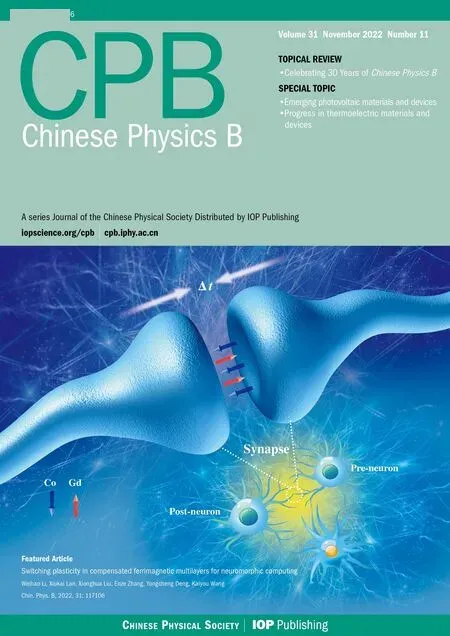CrAlGe: An itinerant ferromagnet with strong tunability by heat treatment
Zhaokun Dong(董昭昆) Zhen Wang(王振) Te Zhang(張?zhí)? Junsen Xiang(項(xiàng)俊森)Shuai Zhang(張帥) Lihua Liu(劉麗華) and Peijie Sun(孫培杰)
1Department of Physics,Beijing Engineering Research Center of Detection and Application for Weak Magnetic field,University of Science and Technology Beijing,Beijing 100083,China
2Beijing National Laboratory for Condensed Matter Physics,Institute of Physics,Chinese Academy of Sciences,Beijing 100190,China
3University of Chinese Academy of Sciences,Beijing 100049,China
4Songshan Lake Materials Laboratory,Dongguan 523808,China
We present a comprehensive investigation on CrAlGe and realize that it is an itinerant ferromagnet with strong tunability of the Curie temperature TC and the spontaneous moment μ0 depending on annealing heat treatment.While the value of TC was previously reported to be 80 K with μ0 ≈0.41μB,in this work the two quantities attain values as high as 170 K and 0.66μB, respectively. Heat treatment does not cause changes of the lattice parameters and symmetry, but results in a slight narrowing of the Bragg peaks. The strong tunability of the itinerant ferromagnetism indicates significantly tunable hybridization between the Cr 3d electrons and the conduction bands, in agreement with the dominant Cr–Al/Ge bonds of this compound. Further tuning along the same line towards even stronger or weaker itinerant ferromagnetism promises an interesting follow-up to clarify the localized-itinerant duality of the 3d electrons in this compound.
Keywords: itinerant ferromagnet,localized-itinerant duality,heat treatment,hybridization
Cooperative magnetism of itinerant d electrons is at the heart of modern condensed matter physics and closely related to a variety of emergent quantum phenomena such as unconventional superconductivity,[1]Mott metal–insulator transition,[2]and non-Fermi liquid.[3]In many of such systems, significant hybridization between the narrow d bands and extended conduction bands gives rise to strongly correlated electron behaviors with generally competing localized and itinerant electronic states. In spite of intensive investigations in the past decades, a satisfactory description of the magnetic phase transitions therein,which are frequently intertwined with some kind of quantum phenomena like unconventional superconductivity,still remains challenging.[4]
In this work,we focus on the ferromagnetic metal CrAlGe that crystallizes in the orthorhombic TiSi2-type structure with space groupFddd(No. 70). Previous studies on this compound show that the Curie temperatureTC= 80 K and the spontaneous momentμ0=0.41μB(Refs. [5–7]). The crystal structure of CrAlGe is characterized by a random occupation of Al and Ge at the 16fWyckoff site, whereas Cr occupies the 8asite independently.[5]The projectedabplane consists of Al/Ge polyhedrons, of which Cr atoms are located at the center.[7]Random occupation of the nonmagnetic atoms Al and Ge appears to be crucial to the cooperative magnetism in this compound. For example,complex ferromagnetic cluster state was found to develop in CrAlGe subsequent to the ferromagnetic transition, and was ascribed to the Al/Ge disorder that results in competing magnetic interactions derived from Cr–Al and Cr–Ge bonds.[7]By contrast,the values of the Curie temperature and the spontaneous moment are substantially higher in MnAlGe, withTC=503 K andμ0=1.7μB(Ref.[8]). The latter compound crystallizes in a related structure of tetragonal Cu2Sb-type and no chemical disorder takes place.
By studying the structural,magnetic,transport,and thermodynamic properties of CrAlGe,we show that the values ofTCandμ0in this compound are highly tunable with annealing heat treatment. This tunability indicates an important effect of the degree of crystallinity and/or the atomic disorder on the itinerant ferromagnetism. Interestingly, a good correlation of the strongly varied spontaneous momentsμ0(between 0.41μBand 0.66μB) andTC(between 80 K and 170 K) is observed,suggestive of a localized-itinerant duality of the pertinent 3d bands and an intrinsic cooperative ferromagnetism following the Rhodes–Wohlfarth curve for ferromagnetic metals,[9]which relates the ordered moment toTC. Compared to the chemical substitution studies that have also revealed varied values ofTCandμ0,[10]annealing heat treatment of certain sample may yield much more reliable information on the ferromagnetic ordering and the associated spin fluctuations. The strong tunability will be discussed based on the disordered but dominant Cr–Al/Ge bond that forms the basis of the hybridization between Cr 3d and conduction bands.
The ploycrystalline CrAlGe samples were prepared by directly arc-melting stoichiometric Cr, Al, and Ge elements.Because considerable secondary phases were observed in the x-ray diffraction of the as-cast sample (Fig. 1(a)), annealing heat treatment in vacuum was carefully carried out to improve the sample quality. Prior to that, differential thermal analysis(DTA)was performed, which shows that CrAlGe melts at about 890°C,see Fig.1(b). We therefore choose four slightly lower temperatures of 700°C, 750°C, 800°C, and 850°C to anneal the sample for 24 h. In the following, we denote these samples by S700, S750, S800, and S850, respectively.The powder x-ray diffraction was measured by using a Rigaku SmartLab diffractometer. The dc magnetic susceptibility and magnetization measurements were carried out in an MPMSSQUID (Quantum Design) magnetometer. The electrical resistivity was measured by a standard four-probe method, the specific heat by a thermal-relaxation method,and the seebeck effect by using one heater and two thermometers in a PPMS(Quantum Design).
The x-ray diffraction patterns recorded at room temperature for the four annealed samples, as well as the as-cast one are shown in Fig. 1(a). These results are in general in agreement with the data of previous reports.[5–7]While traces of secondary phases, mainly of unreacted Ge, can be discerned for S700 and S850, the samples S750 and S800 are single phase within the resolution limit of the current x-ray diffraction data. The lattice parameters obtained from the x-ray diffraction data for S800 area=0.4750 nm,b=0.8224 nm,andc=0.8695 nm,which are practically identical for all the samples. The considerably different magnetic properties of these compounds (to be shown below) prompt us to have a close inspection of the Bragg peaks with different annealing temperatures. As shown in Fig.1(c)for the(131)reflections,one can discern that they are slightly different in broadness,which increases gradually in the order of S800, S750, S700 and S850. Assuming that the powders used for x-ray diffraction here are similar in size and shape for all the samples,the slightly different widths of the Bragg peaks indicate naively different degrees of local fluctuation of the lattice parameters. As will be shown below, the width of Bragg peaks can be roughly correlated withTC,i.e.,the samples with narrower Bragg peaks tend to have higher values ofTC. The reason why the samples S700 and S850 show broader Bragg peaks can be easily inferred from the DTA analysis (Fig. 1(b)). Probably,700°C is too low to allow for an enough thermal relaxation of the Al and Ge atoms, whereas 850°C is too close to the melting point.
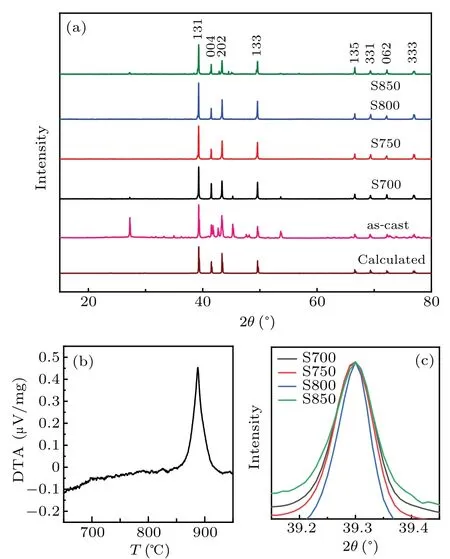
Fig.1. (a)Powder x-ray diffraction patterns of the samples annealed at different temperatures,as compared to that of the as-cast sample. Calculated Bragg peaks are also shown for comparison. (b)The DTA thermogram of the as-cast CrAlGe sample. (c)Closeup of the(131)reflections,where slightly varied widths indicative of different crystallinities or Al/Ge disorders are observed.

Table 1. Magnetic and transport parameters characterizing the itinerant ferromagnetism in CrAlGe of different annealing heat treatments. The sample used in the previous work[5]was annealed at 800°C.It,however,shows considerably different strengths of ferromagnetism to our S800 sample. The reason remains to be clarified.
In Fig. 2 we show the magnetic susceptibilityχ(T) (inset) and the correspondingχ-1(T) (main panel) for all the annealed samples. The applied external field was 1 T.Abrupt upturn inχ(T)indicating ferromagnetic transition is observed at much higher temperatures compared to the previously reported one (see below for the procedure to locateTC). The values ofTC,which are tabulated in Table 1,vary significantly from 80 K (Ref. [5]) to 170 K of the sample S800. A bifurcation of the field-cooled and zero-field-cooledχ(T)in small fields(<200 Oe)has been reported before and ascribed to the onset of ferromagnetic cluster glass state.[7]Similar behaviors have also been observed in our samples with much higher values ofTC(not shown). By applying the Curie–Weiss law to the high temperature part (T >200 K) whereχ-1(T) is linear,one can obtain the paramagnetic Curie temperatureθpand the effective momentμeff,see Table 1. Compared to those reported previously, all our samples show much higher values ofθpindicating greatly enhanced ferromagnetic interaction,though the values ofμeffare all similar.

Fig.2. The magnetic susceptibility χ(T)(inset)and the corresponding inverse magnetic susceptibility χ-1(T) (main panel) as a function of temperature. The applied external field was 1 T.
To shed more light on the tunable ferromagnetism, in Fig. 3(a) we show the isothermal magnetizationM(B) measured at various temperatures for the S800 sample, with the highestTCin this work. Re-plotting these data asM2versusH/M(the Arrott plot) in Fig. 3(b), one can accurately derive the values ofμ0andTC:μ0is obtained by linearly extrapolating isothermalM2versusH/MtoH/M=0(see the dotted line in Fig.3(b)), andTCas the temperature whereμ0(T)reduces to zero,see Fig.3(b)inset.Here,we obtainμ0=0.66μBandTC=170 K for S800. The varied strengths of the itinerant ferromagnetism in different CrAlGe samples are demonstrated in Fig. 3(c), where theM(B) isotherms measured at 2 K for all the samples are compared. TheM(B) curve measured at 5 K for the sample withTC=80 K is reproduced from the literature[5]and shown in Fig. 3(c), too. It is apparent that the samples with higher values ofTCalso have larger spontaneous moments.Moreover,a remarkable two-shoulder feature is observed in all theM(B) curves, manifested as two inflections in the dM/dBversusBcurves(Fig.3(c)inset). The first one at 170 Oe marks the coercive field of the complex ferromagnetic state with glass-like clusters,[7]and the second one at 1.3 T is presumably related to the suppression of the ferromagnetic cluster state. Similar features are also discernible from the data reported previously,[5,7]though not discussed before. Finally, a roughly linear correlation between the values ofTCandμ0is depicted in Fig.3(d). This is reminiscent of the Rhodes–Wohlfarth relation for ferromagnetic metals[9]that relates the ordered moment toTC, offering a strong evidence that the highly tunable ferromagnetism is of an intrinsic feature of CrAlGe. Taking the magnetization value atT=2 K andB=5 T as an approximation to the saturation momentμs(Table 1)for all the samples investigated, one can readily estimate the Rhodes–Wohlfarth ratioμeff/μs,which is expected to be unity for typical ferromagnets with local magnetic moment.As shown in Table 1,while this ratio is much larger than unity in all the samples indicative of dominant itinerant character of the ferromagnetism, it becomes smaller as the value ofTCincreases (for example, 3.22 for S700 versus 2.78 for S800). This observation offers a compelling evidence of the competition from local magnetism,[11]i.e., the local character in CrAlGe is slightly enhanced in the samples with higher values ofTC.
Figure 4 shows the resistivity for all the annealed samples asρ-ρ0versusT. Hereρ0is the residual resistivity. The magnetic transitions can be confirmed as a slope change atTC,see the derivative dρ/dTshown in the inset. The values ofTCobtained here are in good agreement with those determined from the magnetic measurements.The residual resistance ratio RRR=ρ300K/ρ2Kis rather small in all samples,partially due to the atomic disorder between Al and Ge. It,however,has an apparent correlation withTC: the larger the value of RRR,the higher the magnetic transition temperature,see Table 1. Similarly,one can also recognize a correlation between the overall values ofρ–ρ0andTC. This feature, like the correlation between the Rhodes–Wohlfarth ratio andTCas discussed above,suggests again that the itinerant ferromagnetism in CrAlGe suffers competition from the partially localized character of the 3d band. The low temperature resistivity atT <20 K was fitted to the Fermi-liquid descriptionρ=ρ0+AT2and all the fitting parameters are shown in Table 1. TheAvalues, which are in the range of(1.5–1.7)×10-2μΩ·cm·K-2,are three orders of magnitude larger than those of typical ferromagnetic elements[12]like Fe and Ni, indicative of strong spin fluctuations persisting deep into the ordered state of CrAlGe.
The specific heat measured between 2 and 200 K is shown in Fig. 5 for the sample S800. The ferromagnetic transition atTC= 170 K manifests itself as only a weak and broad hump. This is in line with the strong spin fluctuations and the consequently reduced spontaneous moment of this material, considering that the magnetic contribution atTCis proportional toμ20/TC. The low-temperature specific heat,shown in Fig. 5 inset, follows the description ofC/T=γ+βT2,with the electronic specific heat coefficientγ=12 mJ/mol·K2andβ=0.4 mJ/mol·K4, from which the Debye temperatureθD=244 K can be obtained.
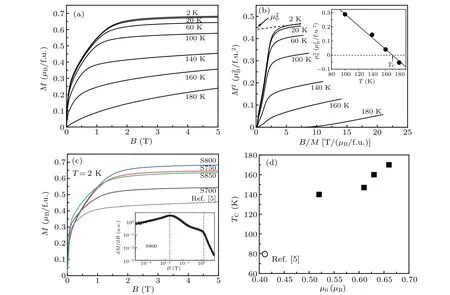
Fig. 3. (a) Isothermal magnetization M(B) measured at various temperatures for the sample S800. (b) The same data of panel (a) shown as M2 versus H/M plots,i.e.,the Arrott plot. The spontaneous magnetic moment μ0 is obtained by extrapolating H/M to zero,see the dashed line. Inset shows μ20 versus temperature,from which TC is read as the temperature where μ0=0. (c)M(B)measured at 2 K for all the samples investigated in this work,as compared to the literature value of the sample with TC=80 K.Inset shows the corresponding field derivative dM/dB for S800. (d)TC versus μ0 for various CrAlGe samples investigated.
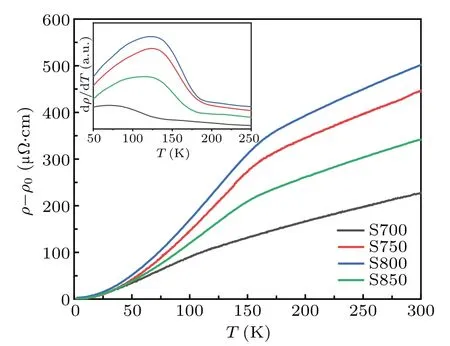
Fig.4.The electrical resistivity of CrAlGe as a function of temperature.Inset shows dρ(T)/dT,where a kink can be observed at TC.
The Seebeck coefficientS(T), as a sensitive transport probe of spin fluctuations, is shown in Fig. 6 for the samples S800 and S850. TheS(T) values of S800 (TC=170 K)are roughly 5 μV/K higher than those of S850 (TC=147 K)atT >100 K. The room-temperature Seebeck coefficient of S800,S=45 μV/K, is considerably large compared to that of typical d-electron ferromagnetic metal, like Fe (17 μV/K,Ref. [13]) and Ni (-20 μV/K, Ref. [14]). This is consistent with the conclusion of the recent studies that have pointed out the existence of enhanced Seebeck effect in itinerant magnetic systems with strong spin fluctuations.[15,16]The absence of clear signature atTCin theS(T) curves is related, at least partially, to the complex magnetic state due to ferromagnetic cluster glass.[7]
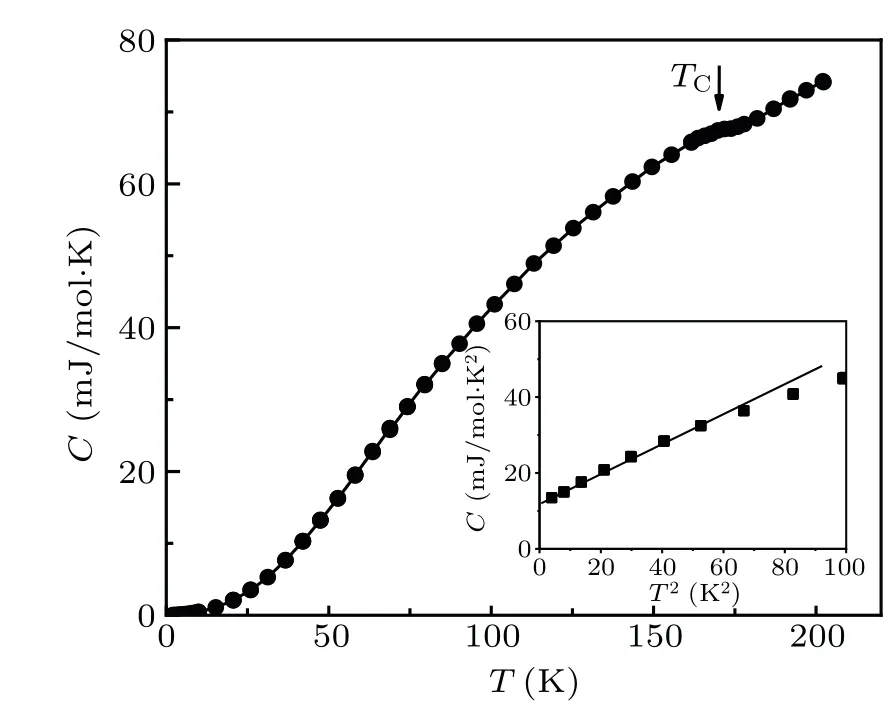
Fig. 5. The specific heat as a function of temperature for the CrAlGe sample S800. The ferromagnetic transition at TC=170 K is marked by a broad and weak hump. Inset shows C/T versus T2 for T <10 K.
First-principles total energy calculations[17]predict a ferromagnetic ground state of CrAlGe with ordered moments of 1.0μB.Although the values ofμ0observed in our work are significantly larger than the previously observed one,they are still smaller than the theoretical expectation by more than 30%.By contrast, in MnAlGe where Al and Ge occupy two distinct atomic sites,the calculated magnetic moment per formula unit~1.7μBis in well agreement with the observations.[8,17]Markedly, the disorder between Al and Ge in CrAlGe can cause the magnetic moment on Cr varying locally from site to site, albeit with an unchanged average moment per formula unit.[17]The locally varied magnetic moments caused by Al/Ge disorder indicate a strongly varied hybridization between Cr 3d band and conduction bands of Al or Ge. This feature can likely be rooted in the crystal structure of CrAlGe,[7]
where the Cr–Al/Ge bond (2.563 ?A) in theabplane is much stronger than the Cr–Cr bond(3.218 ?A).This situation is different from MnAlGe that has much stronger Mn–Mn bond inabplane (~2.8 ?A).[17]On the other hand, the Cr–Cr bond alongcis even weaker,with the interatomic distance 4.747 ?A.
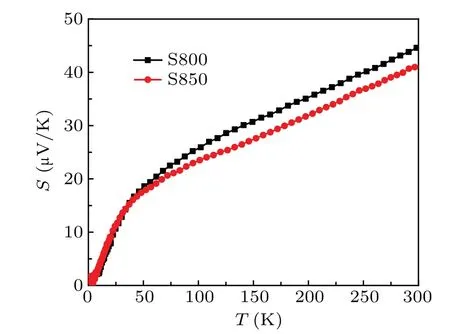
Fig. 6. The Seebeck coefficient as a function of temperature for the CrAlGe samples S800 and S850.
CrAlGe has been predicted to be half metallic with a high spin polarization ratioP= 99% (Refs. [17,18]), where the electronic density of states of the spin-up channel is nearly fully gaped. Looking carefully into the spin resolved electronic density of states,[17]one can find a sharp feature at the gap edge of the spin-up channel,near which the Fermi level is located. This band feature indicates that a local fluctuation of the Fermi level due to the locally varied hybridization of the Cr–Al/Ge bonds may cause a significant change of spin polarization ratio. This provides a naive explanation to the strong tunability of the itinerant ferromagnetism in CrAlGe.
In conclusion,we have found that the itinerant ferromagnetism in CrAlGe is strongly tunable with annealing heat treatment,with the values ofTCand the spontaneous moment being much higher than those reported in literature. A good correlation between the spontaneous moment andTCindicates that the magnetic tunability is an intrinsic feature of this compound, hinting at a strong instability of the cooperative magnetism in response to the varied local crystallographic surroundings caused by Al/Ge disorder. Such disorder-induced instability offers a framework to interpret the competition between the itinerant and the localized character of the 3d band.This inference appears to be reasonable in view of the unique crystal structure where Cr is strongly bonded with Ge/Al, a feature highlighting the importance of the hybridization between Cr 3d band and conduction bands of Al or Ge. More efforts along this line are called for to further extend the range of tunability, towards an even stronger or even weaker ferromagnetism.
Acknowledgements
Project supported by the National Natural Science Foundation of China (Grant Nos. 52088101, 11974389,and 12141002), the National Key Research and Development Program of China (Grant Nos. 2021YFA0718702 and 2017YFA0303100), and the Chinese Academy of Sciences through the Scientific Instrument Developing Project (Grant No.ZDKYYQ20210003),and the Strategic Priority Research Program(Grant No.XDB33000000).
- Chinese Physics B的其它文章
- Microwave absorption properties regulation and bandwidth formula of oriented Y2Fe17N3-δ@SiO2/PU composite synthesized by reduction–diffusion method
- Amplitude modulation excitation for cancellous bone evaluation using a portable ultrasonic backscatter instrumentation
- Laser-modified luminescence for optical data storage
- Electron delocalization enhances the thermoelectric performance of misfit layer compound(Sn1-xBixS)1.2(TiS2)2
- TiO2/SnO2 electron transport double layers with ultrathin SnO2 for efficient planar perovskite solar cells
- Sputtered SnO2 as an interlayer for efficient semitransparent perovskite solar cells

